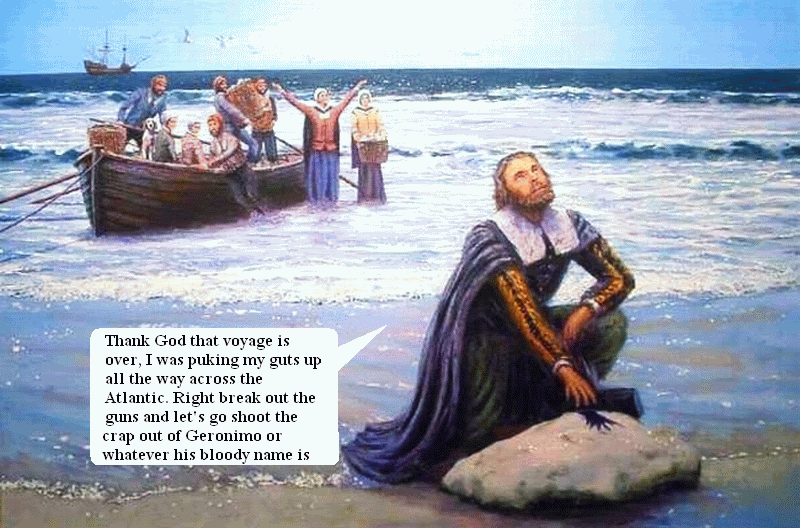1620 : Mayflower Pilgrims come ashore at Plymouth Harbour
On 18 December 1620, passengers on the British ship Mayflower come ashore at modern-day Plymouth, Massachusetts, to begin their new settlement, Plymouth Colony.
The famous Mayflower story began in 1606, when a group of reform-minded Puritans in Nottinghamshire, England, founded their own church, separate from the state-sanctioned Church of England. Accused of treason, they were forced to leave the country and settle in the more tolerant Netherlands. After 12 years of struggling to adapt and make a decent living, the group sought financial backing from some London merchants to set up a colony in America. On 6 September 1620, 102 passengers – dubbed Pilgrims by William Bradford, a passenger who would become the first governor of Plymouth Colony – crowded on the Mayflower to begin the long, hard journey to a new life in the New World.
On 11 November 1620, the Mayflower anchored at what is now Provincetown Harbour, Cape Cod. Before going ashore, 41 male passengers – heads of families, single men and three male servants – signed the famous Mayflower Compact, agreeing to submit to a government chosen by common consent and to obey all laws made for the good of the colony. Over the next month, several small scouting groups were sent ashore to collect firewood and scout out a good place to build a settlement. Around 10 December, one of these groups found a harbour they liked on the western side of Cape Cod Bay. They returned to the Mayflower to tell the other passengers, but bad weather prevented them reaching the harbour until 16 December. Two days later, the first group of Pilgrims went ashore.
After exploring the region, the settlers chose a cleared area previously occupied by members of a local Native American tribe, the Wampanoag. The tribe had abandoned the village several years earlier, after an outbreak of European disease. That winter of 1620-21 was brutal, as the Pilgrims struggled to build their settlement, find food and ward off sickness. By spring, 50 of the original 102 Mayflower passengers were dead. The remaining settlers made contact with returning members of the Wampanoag tribe and in March they signed a peace treaty with a tribal chief, Massasoit. Aided by the Wampanoag, especially the English-speaking Squanto, the Pilgrims were able to plant crops – especially corn and beans – that were vital to their survival. The Mayflower and its crew left Plymouth to return to England on 5 April 1621.
Over the next several decades, more and more settlers made the trek across the Atlantic to Plymouth, which gradually grew into a prosperous shipbuilding and fishing centre. In 1691, Plymouth was incorporated into the new Massachusetts Bay Association, ending its history as an independent colony.
On 18 December 1620, passengers on the British ship Mayflower come ashore at modern-day Plymouth, Massachusetts, to begin their new settlement, Plymouth Colony.
The famous Mayflower story began in 1606, when a group of reform-minded Puritans in Nottinghamshire, England, founded their own church, separate from the state-sanctioned Church of England. Accused of treason, they were forced to leave the country and settle in the more tolerant Netherlands. After 12 years of struggling to adapt and make a decent living, the group sought financial backing from some London merchants to set up a colony in America. On 6 September 1620, 102 passengers – dubbed Pilgrims by William Bradford, a passenger who would become the first governor of Plymouth Colony – crowded on the Mayflower to begin the long, hard journey to a new life in the New World.
On 11 November 1620, the Mayflower anchored at what is now Provincetown Harbour, Cape Cod. Before going ashore, 41 male passengers – heads of families, single men and three male servants – signed the famous Mayflower Compact, agreeing to submit to a government chosen by common consent and to obey all laws made for the good of the colony. Over the next month, several small scouting groups were sent ashore to collect firewood and scout out a good place to build a settlement. Around 10 December, one of these groups found a harbour they liked on the western side of Cape Cod Bay. They returned to the Mayflower to tell the other passengers, but bad weather prevented them reaching the harbour until 16 December. Two days later, the first group of Pilgrims went ashore.
After exploring the region, the settlers chose a cleared area previously occupied by members of a local Native American tribe, the Wampanoag. The tribe had abandoned the village several years earlier, after an outbreak of European disease. That winter of 1620-21 was brutal, as the Pilgrims struggled to build their settlement, find food and ward off sickness. By spring, 50 of the original 102 Mayflower passengers were dead. The remaining settlers made contact with returning members of the Wampanoag tribe and in March they signed a peace treaty with a tribal chief, Massasoit. Aided by the Wampanoag, especially the English-speaking Squanto, the Pilgrims were able to plant crops – especially corn and beans – that were vital to their survival. The Mayflower and its crew left Plymouth to return to England on 5 April 1621.
Over the next several decades, more and more settlers made the trek across the Atlantic to Plymouth, which gradually grew into a prosperous shipbuilding and fishing centre. In 1691, Plymouth was incorporated into the new Massachusetts Bay Association, ending its history as an independent colony.
















































